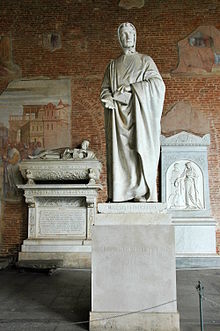Fibonacci
Fibonacci, also known as Leonardo Pisano (c. 1170 - c. 1250 AD), was a famous Italian mathematician.[1][2]

Probably born in Pisa, Italy, Fibonacci was raised and educated in North Africa. This was because his father was a diplomat for the Republic of Pisa.[1][2] While in North Africa, Fibonacci studied mathematics with an Arab teacher. Later, Fibonacci traveled to many different places, including Egypt, Syria, Sicily, and Greece, "where he studied different numerical systems and methods of calculation."[2]
After his travels, Fibonacci returned to Pisa. He wrote many mathematical texts, including Liber Abaci. This text became very famous and popularized the Hindu-Arabic numeral system in Europe.[1][2] He also introduced the Fibonacci Sequence to Europe.[1]
The Fibonacci Sequence is infinitely large, but it begins like this: 1, 1, 2, 3, 5, 8, 13, 21, 34, 55, 89, etc. Each number is the sum of the two numbers that come before it. Also, when one number is divided by the one that comes right before it, the result gets closer and closer to the golden ratio.[1]